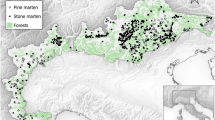Abstract
Little is known about processes regulating population dynamics in termites. We investigated the distribution of mound-colonies of the fungus-cultivating termite Macrotermes bellicosus (Smeathman) in two habitats in the Comoé National Park (Côte d'Ivoire) with nearest-neighbour analysis differentiating between different age classes. These results were compared with ecological data on processes influencing population dynamics. High mound densities were recorded in shrub savannah while only a few mounds were found in gallery forest. Mounds were distributed randomly in both habitats when all mounds were considered together, and when inhabited and uninhabited mounds were treated separately. However, distinctive non-random patterns were revealed in the savannah when we distinguished between different age classes. Small, young colonies were aggregated when they coexisted with larger, older colonies, which were more regularly distributed. This indicates that the distribution of older colonies is influenced by intraspecific competition whereas that of younger colonies is influenced by opposing factors that lead to aggregation. This is in accordance with ecological data. Food is a limiting resource for large colonies, while patchily distributed appropriate microclimatic conditions seem to be more important for young colonies. Colonies that had formerly coexisted (i.e. living colonies and recently dead colonies) showed aggregated, random and regular distribution patterns, suggesting several causes of mortality. Colonies that had never had contact with each other were randomly distributed and no specific regulation mechanism was implicated. These results show that different age classes seem to be regulated by different processes and that separation between age classes is necessary to reveal indicative spatial patterns in nearest-neighbour analysis.
Similar content being viewed by others
Author information
Authors and Affiliations
Additional information
Electronic Publication
Rights and permissions
About this article
Cite this article
Korb, J., Linsenmair, K. The causes of spatial patterning of mounds of a fungus-cultivating termite: results from nearest-neighbour analysis and ecological studies. Oecologia 127, 324–333 (2001). https://doi.org/10.1007/s004420000597
Received:
Accepted:
Published:
Issue Date:
DOI: https://doi.org/10.1007/s004420000597




